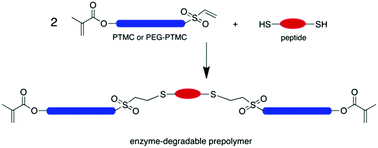High modulus, enzyme-degradable poly(trimethylene carbonate)–peptide biohybrid networks formed from triblock prepolymers†
Abstract
Biohybrid networks have the potential to have stiffnesses equivalent to that of native soft connective tissues as well as cell-mediated degradation behavior. Most strategies to generate such materials to date have utilized crosslinking of two separate and orthogonally functionalized polymers. Herein we describe a triblock prepolymer consisting of a central enzyme degradable peptide block flanked by two synthetic, hydrolysis resistant poly(trimethylene carbonate) blocks (PTMC) or poly(ethylene glycol)–PTMC blocks terminated in methacrylate groups. To form these prepolymers heterobifunctional PTMC and PEG–PTMC were prepared, possessing a vinyl sulfone terminus and a methacrylate terminus. These polymers were conjugated to a di-cysteine containing peptide through a Michael-type addition to form cross-linkable prepolymers. These prepolymers were then photo-cured to form enzyme degradable networks. The compressive moduli of the resulting water swollen networks was within the range of many soft connective tissues and was inversely proportional to the water solubility of the prepolymers. The prepolymer water solubility in turn could be tuned by adjusting PTMC molecular weight or by the addition of a PEG block. In vitro degradation only occurred in the presence of matrix metalloproteinases, and was fastest for networks prepared with prepolymers of higher water solubility.



 Please wait while we load your content...
Please wait while we load your content...